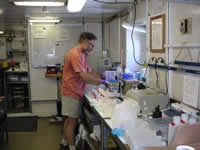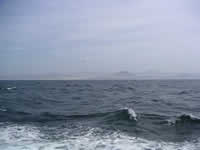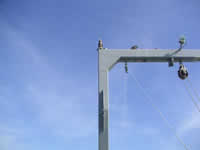


|
The Project Part 1: Part 2: Part 3:
|
26 July, 2005
|
 Fred wondering if his theory will stand up to scrutiny!  The east coast of Baja, California  Boobies ride along with us |
At 9:00 am this morning we are rounding the southern tip of the Baja peninsula. We can see high peaks and giant stretches of sand. Soon we will enter the waters of the Gulf of California. The temperature is rising steadily and the sun is strong. We have passed over the Tropic of Cancer. (Can you find this on a map? What is the latitude of the Tropic of Cancer? Does it have a counterpart below the Equator?)
More from The Log from the Sea of Cortez
When John Steinbeck and Ed Ricketts were bent over, searching for marine specimens in the tide pools of Baja’s coast, curious local boys would ask, “What did you lose?”
They replied, “Nothing.”
“Then what do you search for?”
“We search for something that will seem like truth to us; we search for understanding; we search for that principle which keys us deeply into the pattern of all life; we search for the relations of things, one to another.”
Scientists from all the different disciplines systematically observe and collect facts (data). Then they develop theories that help them to sort and merge the data they have collected. Scientific theories consist of general principles or laws that attempt to explain how and why something happens or happened.
Scientific theories are not accepted until they have been reviewed, tested and confirmed to be true by other scientists. This is called the peer review system. This fact, that all science must be verified (and sometimes many times over), makes it unique among the knowledge mankind has accumulated over the years. No one can scientifically judge to be true or not a work of philosophy, literature or art.
Scientific inquiry is unique in another way. Old theories and ideas are discarded when new investigations prove them to be unsound. New science replaces old science; unlike old works of art or literature, which remain intact within the body of human accomplishment.
I asked Fred, the chief scientist on this expedition, if scientists’ egos get bruised when new theories replace the old. He said that even if a theory proves to be unsound, it has caused someone to think about the previous work, and perhaps the new work could not have been done without the old.
Math Question:
Right now where we are in the Gulf of California, the water temperature is 28.54° Celsius. The air temperature is 26.43° Celsius. Can you convert these numbers to Fahrenheit? Would you like this climate? Is it a good temperature to swim in?
Trivia Tidbit of the Day:
Do you know what the phrase “high seas” signifies? It has nothing to do with the height if the waves. It refers to areas of the ocean that lies outside the authority of any nation, usually 200 nautical miles from coast of the nation. The high seas are also called international waters. All nations are expected to follow international rules regarding the high seas. Under international law, the high seas are open to every nation for fishing, travel, and research. All nations have equal rights on the high seas and must respect one another's rights.
Some of this information is from The World Book Multimedia Encyclopedia, 2000 World Book
![]()
